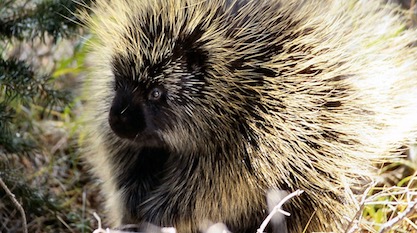 Intelligent Design
Intelligent Design
Porcupine Quills and Other Examples of Nature’s Foresight


Editor’s note: We are delighted to offer the recently launched series “Modernizing Darwin,” cross-posted at Shabbat.com, by Geoffrey Simmons, MD. Dr. Simmons is the author of What Darwin Didn’t Know and Billions of Missing Links. He is a Fellow with Discovery Institute’s Center for Science & Culture.
The average porcupine has 30,000 needle-sharp quills, each with 800 barbs at the tip. Usually, these miniature spears lie flat along the back, sides, and tail of the animal. But if it’s attacked, they suddenly leap up for defense. The quills aren’t thrown, despite popular ideas on that score. An attacker, such as a dog, badger, or fox, can easily get a very painful snout full. Each quill only requires half the strength of a hypodermic needle for insertion and that isn’t much. Yet a newborn porcupine passes through its mother’s birth canal without causing her any injuries. How?
The answer, of course, is that the quills are soft. They stiffen a few hours after delivery. Otherwise, there would never have been another generation of porcupines. Is this designed with foresight? It definitely seems so. This could not have happened by natural selection or trial and error.
Horse Foals and Giraffe Calves
In a similar fashion, horse foals and giraffe calves are born with temporary, gelatinous coverings on their razor-sharp hooves. The pangolin or scaly anteaters of Africa and Southeast Asia have razor-sharp scales covering their entire body. These are not like reptile or fish scales, but made of the same material as claws. Nonetheless, they are born with soft scales that rapidly harden when exposed to air. Is this a lucky accident (for the mom)?
How does it happen that hardening of quills, hooves, and scales is delayed until after birth? If that trait wasn’t present from the beginning, there would have been either no hard quills or hooves, or no live births. Nature doesn’t get to experiment if the trait is essential from the beginning.
Take the bat. It has long leg muscles that insert in its upper torso, so that when it lands (upside down) the weight of the hanging torso quickly pulls the talons closed. One might also admire the planning that has them spinning vertically to defecate/urinate. All the while staying quite clean.
Humans are loaded with evidence of foresight. Some of our teeth are adapted for grinding and some for biting. Each person’s mouth is unique, such that we use dental records in crime investigations. Yet the top and bottom teeth fit together, despite having grown separately. If you’ve ever had a crown you know it’s painful if they don’t fit.
We are also able to construct collateral circulation (new blood vessels) where blood vessels have been blocked, as in a heart attack. Oftentimes, injured nerves can regenerate. The body re-uses factors present in development to aid in healing.
In a range of what I call what if/what then plans, all suggestive of foresight, we have reflexes designed to protect us. We sneeze to get rid of irritants in our nose, cough to clear our throat or lung passages, hiccough to dislodge food in our esophagus, vomit to get rid of toxic material in our stomach, and create diarrhea to eliminate a variety of irritants and infectious agents. If we touch something burning hot, we quickly pull away. If there’s a glare, we squint. If we’re cut, we clot off the wound.
The Most Impressive Display
Perhaps the most impressive display of foresight is the timing of a human baby’s first breath. If a newborn takes that breath while in the birth canal (too soon), she suffocates. If the breath is taken too late, she dies of hypoxia. The assumption is that the sudden change in environment and/or temperature triggers that breath. Also, a major blood vessel near the heart (the ductus arteriosus), which shunts blood past the lungs in utero, simultaneously closes so blood can now pick up oxygen in the lungs. Beforehand, the lungs were filled with amniotic fluid.
Then, is it a coincidence, natural selection, or design that a mother’s milk has large volumes of water and the exact nutrients, vitamins, salts, and antibodies the baby needs? Could this milk have come about by trial and error until our ancestors got it right? It would be too bad for babies if mutation and selection had to try formulas for a few hundred thousand years. Not likely. And then there is the milk delivery system. It has to be ready when the baby is born. That process starts nine months before.
In fact, for successful reproduction of a mammal like us, these things are required: lactation (multicomponent), placental development (not simple), the uterus (a highly specialized structure), hormonal control (also multicomponent), the birth process as described above, including the first breath and all that takes, and egg and sperm, which require their own production and delivery systems. To develop such a complex interacting system without foresight would be impossible.
Constructive questions and courteous comments will be appreciated.
Photo: North American porcupine, by National Park Service, via Wikimedia Commons.
